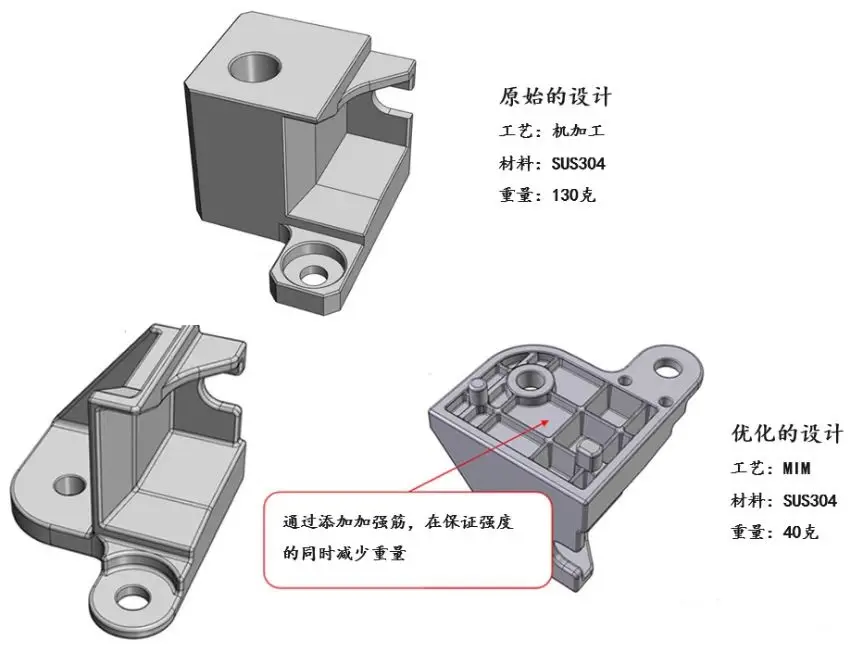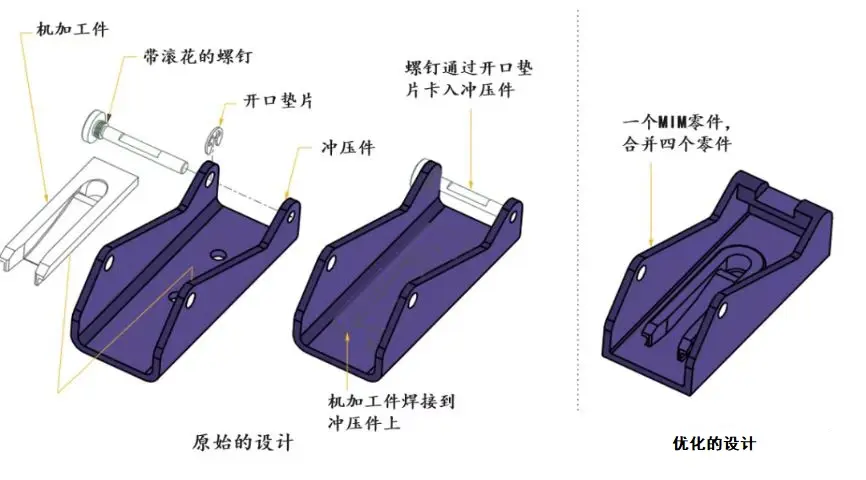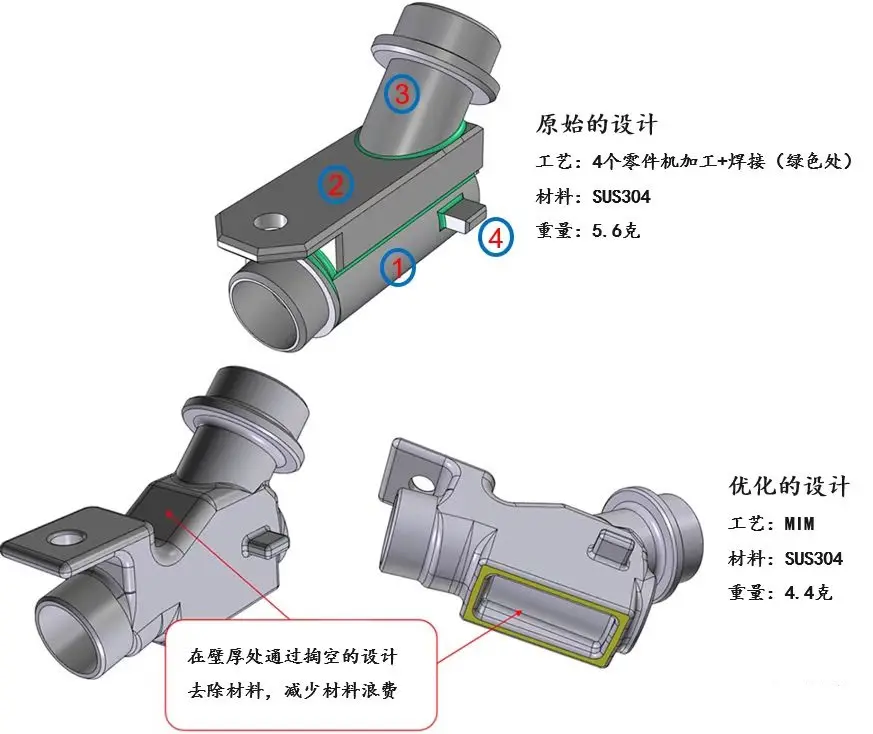MIM Manufacturing: Advanced Metal Injection Molding Solutions for Precision Parts
Metal Injection Molding (MIM) is an innovative manufacturing process that combines the versatility of plastic injection molding with the strength and integrity of powder metallurgy. This advanced technique is particularly useful for producing small, intricate metal parts with high precision. In this article, we will explore the MIM manufacturing process, its benefits, and applications, and highlight Welleshaft as a trusted global supplier and contract manufacturer for all your MIM needs.
What is MIM in Manufacturing?
Metal Injection Molding (MIM) is a manufacturing process that involves mixing metal powders with a binder material to create a feedstock. This feedstock is then injected into a mold, debinded to remove the binder, and sintered to form solid metal parts. The MIM process allows for the production of complex shapes and high-precision components that would be difficult or impossible to achieve with traditional manufacturing methods.
Section 1: The MIM Manufacturing Process
1. Step Description
| Feedstock Mixing | Fine metal powders are mixed with a binder, typically a combination of thermoplastic and wax, to form a feedstock with the consistency of plastic. |
| Injection Molding | The feedstock is injected into a mold cavity using conventional injection molding equipment, forming a “green” part that retains the shape of the mold. |
| Binder Removal | The binder is removed from the green part through a process called debinding. This can be done chemically, thermally, or through a combination of both methods. |
| Sintering | The debound part, now referred to as a “brown” part, is heated in a controlled atmosphere to a temperature below the melting point of the metal. |
| Post-Processing | The sintered part may undergo additional processes such as machining, heat treatment, or surface finishing to achieve the desired properties and tolerances. |

Section 2: Advantages of MIM Manufacturing
1.Complex Geometries
Description: MIM can produce intricate shapes and complex geometries that would be difficult or impossible to achieve with traditional manufacturing methods.
Benefit: Enables the creation of components with detailed features, thin walls, and undercuts.
2.Material Utilization
Description: MIM minimizes material waste compared to subtractive manufacturing methods.
Benefit: More efficient use of materials, reducing costs and environmental impact.
3.High Production Rates
Description: Injection molding allows for high-volume production with consistent quality.
Benefit: Suitable for mass production of small, precision components.
4.Superior Mechanical Properties
Description: MIM parts typically have high density and excellent mechanical properties, comparable to wrought materials.
Benefit: Produces strong and durable components suitable for demanding applications.
5.Wide Range of Materials
Description: MIM is compatible with a variety of metal powders, including stainless steel, titanium, and superalloys.
Benefit: Flexibility to choose materials based on specific application requirements.
6.Cost-Effective for Complex Parts
Description: MIM is more cost-effective than machining for complex parts with high precision and tight tolerances.
Benefit: Reduces production costs for intricate components.
7.Reduced Secondary Operations
Description: MIM parts often require minimal post-processing due to their near-net shape.
Benefit: Lowers overall production time and costs.
8.Dimensional Precision
Description: MIM provides high dimensional accuracy and repeatability.
Benefit: Ensures consistency and quality in high-volume production.
9.Surface Finish
Description: MIM parts typically have good surface finish straight out of the mold.
Benefit: Reduces the need for additional finishing processes.
10.Design Flexibility
Description: Allows for design features such as knurled surfaces, internal threads, and multi-material components.
Benefit: Enhances product functionality and aesthetic appeal.

Section 3: Applications of MIM Manufacturing
Metal Injection Molding (MIM) manufacturing is used in a wide range of industries due to its ability to produce complex, high-precision metal parts efficiently. Here are some of the primary applications of MIM:
1. Automotive Industry
Engine Components: Gears, fuel injector nozzles, turbocharger vanes.
Transmission Parts: Shift levers, actuators, sensor housings.
Safety Systems: Airbag components, ABS sensor parts.
2. Medical and Dental Devices
Surgical Instruments: Scissors, forceps, needle holders.
Orthopedic Implants: Bone screws, plates, dental brackets.
Medical Equipment: Components for diagnostic devices, surgical tools.
3. Aerospace and Defense
Aircraft Components: Fasteners, brackets, turbine blades.
Defense Applications: Small arms parts, precision components for weaponry.
Space Exploration: Components for satellites and spacecraft.
4. Consumer Electronics
Mobile Devices: Connectors, hinges, buttons, internal structural components.
Wearables: Watch casings, electronic housings.
Laptops and Tablets: Keyboard frames, internal brackets.
5. Industrial Machinery
Tooling Components: Cutting tools, dies, and molds.
Machinery Parts: Bearings, gears, cams.
Instrumentation: Components for measuring and control devices.
6. Sporting Goods
Golf Equipment: Club heads, weight adjusters.
Firearms: Triggers, hammers, safety levers.
Bicycles: Gear components, braking parts.
7. Power Tools
Drill Components: Gears, chucks, transmission parts.
Saw Components: Blades, motor parts.
Hand Tools: Ratchets, wrench parts.
8. Telecommunications
Connectors: RF connectors, fiber optic components.
Antenna Parts: Housings, brackets.
Switchgear: Components for network switches and routers.
9. Lock and Security Systems
Lock Mechanisms: Tumblers, pins, key cylinders.
Security Devices: Safe locks, electronic security components.
Access Control: Parts for biometric devices, card readers.
10. Jewelry and Luxury Goods
Watch Components: Gears, casings, crowns.
Jewelry Parts: Clasps, settings, decorative elements.
Luxury Pens: Housings, clips, tips.
11. Dental
Orthodontic Brackets: Braces, retainers.
Implants: Crowns, bridges.
Tools: Precision instruments used in dental surgery.
12. Energy Sector
Oil and Gas: Components for drilling equipment, valves, and pumps.
Renewable Energy: Parts for wind turbines, solar panel mounts.
Nuclear Energy: Precision components for reactors.
13. Textile Industry
Textile Machinery Parts: Spindles, guides, tensioners.
Sewing Machines: Precision components, gear systems.
Knitting Machines: Needles, sinkers.
14. Optical and Imaging Equipment
Camera Parts: Lens housings, mounts, shutters.
Microscopy: Precision mounts, adjustment mechanisms.
Projectors: Light guides, frames.
15. Automated Systems and Robotics
Robotic Arms: Joint components, gears, connectors.
Automation Equipment: Precision parts for automation systems.
Sensors and Actuators: Housings, mounts, mechanical parts.
16. Firearms and Defense
Small Arms Components: Triggers, safety levers, firing pins.
Defense Equipment: Precision parts for weaponry and surveillance equipment.
17. Watchmaking
Watch Movements: Gears, escapements, bridges.
Watch Cases: High-precision, aesthetic components.
18. Environmental Technologies
Filtration Systems: Components for water and air filters.
Green Technologies: Parts for energy-efficient devices and systems.
The versatility and precision of MIM make it suitable for a wide array of applications across numerous industries, providing solutions where traditional manufacturing methods may fall short.

Section 4: Welleshaft: Your Trusted Global Supplier and Contract Manufacturer
When it comes to MIM manufacturing, Welleshaft stands out as a trusted global supplier and contract manufacturer. With years of experience and a commitment to quality, Welleshaft provides advanced MIM solutions that meet the highest industry standards. Their expertise in Metal Injection Molding ensures that you receive top-notch components tailored to your specific requirements.
For more information on high-quality MIM Manufacturer and to find the perfect solution for your application, please contact us.
Jinan Welle Metal Products Co., Ltd (Welleshaft)
Website: www.welleshaft.com
Email: [email protected]
Phone: +86-156-5017-9596
Explore our range of durable and reliable MIM Parts today!
Section 5: FAQs about MIM Manufacturing
1.What Does MIM Stand For in Machining?
MIM stands for Metal Injection Molding. It is a manufacturing process that combines metal powders with a binder to create feedstock, which is then injected into molds to form complex metal parts.
2.What is the Difference Between CNC and MIM?
CNC (Computer Numerical Control) machining is a subtractive manufacturing process that involves removing material from a solid block to create a part. MIM, on the other hand, is an additive manufacturing process that involves injecting a mixture of metal powders and binder into a mold to create parts. MIM is more suitable for producing complex shapes and high-precision components, while CNC machining is ideal for simpler geometries and lower production volumes.
3.What is the Difference Between CIM and MIM?
CIM (Ceramic Injection Molding) and MIM (Metal Injection Molding) are similar processes, but they differ in the materials used. CIM involves the use of ceramic powders, while MIM uses metal powders. Both processes involve injecting a mixture of powder and binder into a mold, debinding, and sintering to create complex and precise parts.
4.What is Molding Powder?
Molding powder refers to the fine metal or ceramic powders used in the MIM or CIM process. These powders are mixed with a binder to create a feedstock that is injected into molds to form complex components.
Section 6: MIM vs. Additive Manufacturing
MIM and additive manufacturing (3D printing) are both advanced manufacturing techniques, but they have key differences. MIM is ideal for producing high volumes of complex metal parts with excellent mechanical properties, while additive manufacturing is more suitable for low-volume production and prototyping. MIM offers superior material properties and surface finish, while additive manufacturing provides greater design flexibility and rapid iteration capabilities.
Section 7: Leading MIM Manufacturing Companies
Several companies specialize in MIM manufacturing, offering expertise and advanced capabilities for producing high-quality components. Some of the leading MIM manufacturers include:
- Indo-MIM
- GKN Powder Metallurgy
- Advanced Powder Products (APP)
- Parmaco Metal Injection Molding
- Welle Powder Metallurgy (Welleshaft)
- CMG Technologies
These manufacturers provide a wide range of MIM solutions, from prototyping to large-scale production, catering to various industries and applications.
Conclusion
Metal Injection Molding (MIM) is a versatile and efficient manufacturing process that enables the production of complex and precise metal parts. With its ability to create intricate geometries, maintain high precision, and offer material flexibility, MIM is a valuable solution for industries requiring advanced manufacturing capabilities. Whether for medical, automotive, aerospace, or electronics applications, MIM provides top-tier solutions for precision manufacturing needs.
For more information on how MIM manufacturing can benefit your specific application, consider reaching out to experienced MIM manufacturers like Welleshaft, who can provide tailored solutions and expertise.

